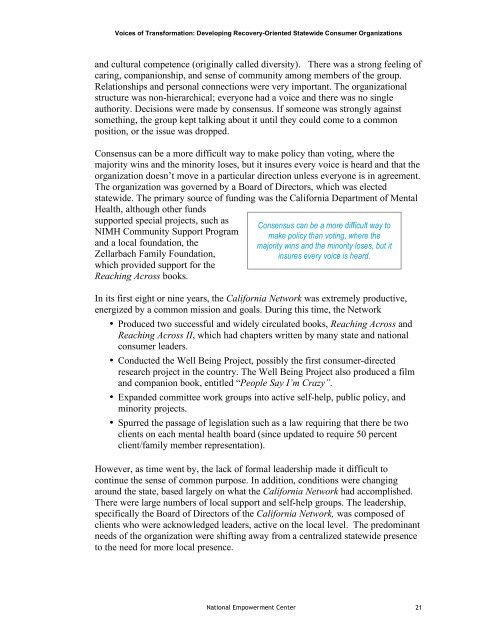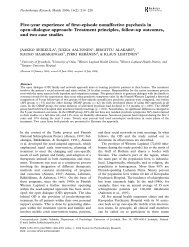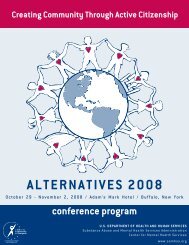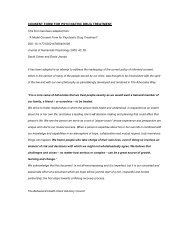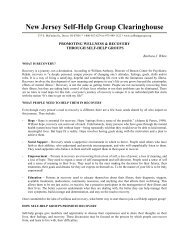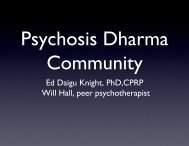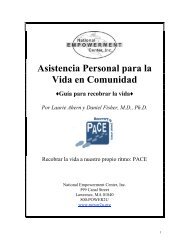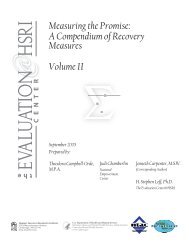Voices of Transformation - National Empowerment Center
Voices of Transformation - National Empowerment Center
Voices of Transformation - National Empowerment Center
Create successful ePaper yourself
Turn your PDF publications into a flip-book with our unique Google optimized e-Paper software.
<strong>Voices</strong> <strong>of</strong> <strong>Transformation</strong>: Developing Recovery-Oriented Statewide Consumer Organizations<br />
and cultural competence (originally called diversity). There was a strong feeling <strong>of</strong><br />
caring, companionship, and sense <strong>of</strong> community among members <strong>of</strong> the group.<br />
Relationships and personal connections were very important. The organizational<br />
structure was non-hierarchical; everyone had a voice and there was no single<br />
authority. Decisions were made by consensus. If someone was strongly against<br />
something, the group kept talking about it until they could come to a common<br />
position, or the issue was dropped.<br />
Consensus can be a more difficult way to make policy than voting, where the<br />
majority wins and the minority loses, but it insures every voice is heard and that the<br />
organization doesn’t move in a particular direction unless everyone is in agreement.<br />
The organization was governed by a Board <strong>of</strong> Directors, which was elected<br />
statewide. The primary source <strong>of</strong> funding was the California Department <strong>of</strong> Mental<br />
Health, although other funds<br />
supported special projects, such as<br />
NIMH Community Support Program<br />
and a local foundation, the<br />
Zellarbach Family Foundation,<br />
which provided support for the<br />
Reaching Across books.<br />
Consensus can be a more difficult way to<br />
make policy than voting, where the<br />
majority wins and the minority loses, but it<br />
insures every voice is heard.<br />
In its first eight or nine years, the California Network was extremely productive,<br />
energized by a common mission and goals. During this time, the Network<br />
• Produced two successful and widely circulated books, Reaching Across and<br />
Reaching Across II, which had chapters written by many state and national<br />
consumer leaders.<br />
• Conducted the Well Being Project, possibly the first consumer-directed<br />
research project in the country. The Well Being Project also produced a film<br />
and companion book, entitled “People Say I’m Crazy”.<br />
• Expanded committee work groups into active self-help, public policy, and<br />
minority projects.<br />
• Spurred the passage <strong>of</strong> legislation such as a law requiring that there be two<br />
clients on each mental health board (since updated to require 50 percent<br />
client/family member representation).<br />
However, as time went by, the lack <strong>of</strong> formal leadership made it difficult to<br />
continue the sense <strong>of</strong> common purpose. In addition, conditions were changing<br />
around the state, based largely on what the California Network had accomplished.<br />
There were large numbers <strong>of</strong> local support and self-help groups. The leadership,<br />
specifically the Board <strong>of</strong> Directors <strong>of</strong> the California Network, was composed <strong>of</strong><br />
clients who were acknowledged leaders, active on the local level. The predominant<br />
needs <strong>of</strong> the organization were shifting away from a centralized statewide presence<br />
to the need for more local presence.<br />
<strong>National</strong> <strong>Empowerment</strong> <strong>Center</strong> 21


